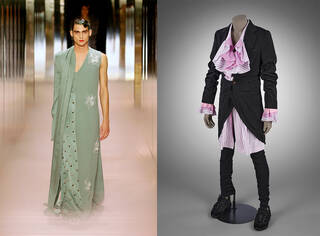Vain trifles as they seem, clothes have, they say, more important offices than merely to keep us warm. They change our view of the world and the world's view of us.
The author Virginia Woolf threaded her love of clothes through her writing, whether novels and short stories, diary entries or even articles for Vogue. Fashion could express two of her essential themes: female experience and the passing of time. In the first half of the 20th century, fashion – encompassing clothes, sewing, shopping and associated magazines – was seen as an exclusively feminine interest. Other modernist writers used fashion's seasonal collections and constant changes as a compelling metaphor for time and transience. Woolf went deeper. She was fascinated by what she called 'frock consciousness,' how our clothing can affect our feelings, and vice versa. All this is most apparent in her time-travelling, binary-blurring, fictional biography: Orlando.

Orlando follows the life of an aristocratic British poet from the 16th century to 1928, the year Woolf published the book. Each time the character Orlando unwittingly skips a century in their sleep, they update their wardrobe to the fashions of the day. Never taking more than 10 minutes, Orlando continually redresses themself, donning a lavish ensemble with rosetted shoes to meet Elizabeth I, wrapping themself in cloaks and robes as Charles I's ambassador to Turkey, arranging the draperies of their skirts on a boat back to Georgian London, buying – and being dragged down by – Victorian crinolines, and finally changing into a pair of whipcord breeches and leather jacket. In this last iteration, the inspiration for Orlando is most recognisable as the writer Vita Sackville-West, Woolf's friend and lover. Sackville-West had started wearing breeches during the First World War (1914 – 18), when women donning trousers was still taboo.
The relationship between clothing and gender presentation is central to the book. Halfway through, Orlando awakes to discover "he was a woman." The resulting change in wardrobe impacts Orlando's behaviour and place in society. As Woolf puts it: "the clothes wear us, not we them." Her restrictive and cumbersome outfits become a metaphor for societal constraints. In frustration, Orlando adopts her younger self's masculine wardrobe to regain her freedom. Woolf's descriptions of the fluidity and performativity of gender, especially through dress, have made the novel increasingly relevant and resonant.

In recent years, as the fashion world has sought to soften the binary distinction of womenswear and menswear, the transformative power of fashion in Orlando has inspired numerous designers. In 2016, Christopher Bailey for Burberry designed a collection rich with references to English sartorial history, playfully mixing ruffs and trench coats, military jackets with delicate patterns. In 2020, Rei Kawakubo, founder of Comme des Garçons designed the costumes for an operatic adaptation of the book in Vienna. She also presented Orlando-themed Comme menswear and womenswear collections at Paris Fashion Week with silhouettes echoing the swelling and constriction of the protagonist's wardrobe. In 2021, renowned menswear designer Kim Jones created a womenswear collection for Fendi, featuring androgynous looks and male models on a catwalk stacked with a Woolfian library with Orlando at its heart.
Nearly a century after writing Orlando, Woolf has found herself back in Vogue.



